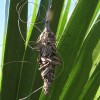Abstract
North American bagworm can feed on over 50 families of deciduous and evergreen trees and shrubs. Severe infestations can damage the aesthetics and health of host plants, especially juniper and arborvitae species. Many of the preferred host plants do not grow well below the USDA hardiness zone 8A, but due to its wide host range, high female fecundity, and method of dispersal, bagworm can still be problematic in the Florida landscape. This 5-page fact sheet was written by Brooke L. Moffis and Steven P. Arthurs and published by the UF Department of Entomology and Nematology, March 2013.
References
Balduf WV. 1937. Bionomic notes on the common bagworm, Thyridopteryx ephemeraeformis Haw., (Lepid., Psychidae) and its insect enemies (Hym., Lepid.). Proceedings of the Entomological Society of Washington 39: 169-184.
Baxendale F, Kalisch JA. 2009. Bagworms. University of Nebraska Lincoln, NebGuide. G1951.
Davis DR. 1964. Bagworm moths of the Western Hemisphere. Bulletin U.S. National Museum, No. 244. 233 p., Washington D.C. https://doi.org/10.5479/si.03629236.244.1
Ellis JA, Walter AD, Tooker JF, Ginzel MD, Reagel F, Lacey ES, Bennett AB, Grossman EM, Hanks LM. 2005. Conservation biological control in urban landscapes: manipulating parasitoids of bagworm (Lepidoptera: Psychidae) with flowering forbs. Biological Control 34: 99-107. https://doi.org/10.1016/j.biocontrol.2005.03.020
FDACS. 1983. Insects of hardwood foliage bagworm. Bull. 196-A.
Gill SA, Raupp MJ. 1994. Using entomopathogenic nematodes and conventional and biorational pesticides for controlling bagworm. Journal of Arboriculture 20: 318-322.
Lemke HD, Raupp MJ, Shrewsbury PM. 2005. Efficacy and costs associated with the manual removal of bagworms, Thyridopteryx ephemeraeformis, from leyland cypress. Journal of Environmental Horticulture 23:123-126. https://doi.org/10.24266/0738-2898-23.3.123
Leonhardt BA, Neal JW, Klun JA, Schwarz M, Plimmer JR. 1983. An unusual lepidopteran sex pheromone system in the bagworm moth. Science 219: 314-316. https://doi.org/10.1126/science.219.4582.314
Peterson A. 1969. Bagworm photographs: eggs, larvae, pupae, and adults of Thyridopteryx ephemeraeformis (Psychidae: Lepidoptera). The Florida Entomologist 52: 61-72. https://doi.org/10.2307/3493728
Rhainds M, Fagan WF. 2010. Broad-scale latitudinal variation in female reproductive success contributes to the maintenance of a geographic range boundary in bagworms (Lepidoptera: Psychidae). PLoS One 5(11):e14166.
https://doi.org/10.1371/journal.pone.0014166
Rhainds M, Davis DR, Price PW. 2009. Bionomics of bagworms (Lepidoptera: Psychidae). Annual Review of Entomology 54: 209-226. https://doi.org/10.1146/annurev.ento.54.110807.090448
Rhainds M, Sadof CS. 2008. Elements of population dynamics (Lepidoptera: Psychidae) on hedge rows of white pine. Annals of the Entomological Society of America 101: 872-880. https://doi.org/10.1093/aesa/101.5.872
Sadof CS, Raupp MJ. 1987. Consumer attitudes toward the defoliation of American arborvitae, Thuja occidentalis, by bagworm, Thyridopteryx ephemeraeformis. Journal of Environmental Horticulture 5: 164-166.
https://doi.org/10.24266/0738-2898-5.4.164
Shetlar DJ. 2010. Bagworm and its control. The Ohio State University Extension Article HGY-2149-10.
Unless otherwise specified, articles published in the EDIS journal after January 1, 2024 are licensed under a Creative Commons Attribution-NonCommercial-NoDerivs 4.0 International (CC BY-NC-ND 4.0) license.

